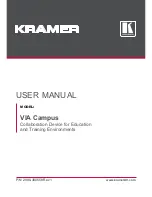External Memory Controller (EMC)
Symphony DSP56724/DSP56725 Multi-Core Audio Processors, Rev. 0
Freescale Semiconductor
21-77
21.4.4.4.3
General-Purpose Signals (GxTx, GOx)
The general-purpose signals (LGPL[5:0]) each have two bits in the RAM word that define the logical value
of the signal to be changed at the rising edge of the bus clock and/or at the falling edge of the bus clock.
LGPL0 offers enhancements beyond the other LGPLx lines.
GPL0 can be controlled by an address line specified in MxMR[G0CLx]. To use this feature, G0H and G0L
should be set in the RAM word. For example, for a SIMM with multiple banks, this address line can be
used to switch between internal memory device banks.
21.4.4.4.4
Loop Control (LOOP)
The LOOP bit in the RAM word specifies the beginning and end of a set of UPM RAM words that are to
be repeated. The first time LOOP = 1, the memory controller recognizes it as a loop start word and loads
the memory loop counter with the corresponding contents of the loop field (shown in
). The
next RAM word for which LOOP = 1 is recognized as a loop end word. When it is reached, the loop
counter is decremented by one.
Continued loop execution depends on the loop counter. If the counter is not zero, the next RAM word
executed is the loop start word. Otherwise, the next RAM word executed is the one after the loop end word.
Loops can be executed sequentially but cannot be nested. Also, special care must be taken in the following
case: LAST and LOOP must not be set together.
21.4.4.4.5
Repeat Execution of Current RAM Word (REDO)
The REDO function is useful for wait-state insertion in a long UPM routine that would otherwise need too
many RAM words. Setting the REDO bits of the RAM word to a nonzero value causes the UPM to
re-execute the current RAM word up to three more times, as defined in the REDO field of the current RAM
word.
Special care must be taken in the following cases:
•
When UTA and REDO are set together, TA is asserted the number of times specified by the REDO
function.
•
When NA and REDO are set together, the address is incremented the number of times specified by
the REDO function.
•
When LOOP and REDO are set together, the loop mechanism works as usual and the line is
repeated according to the REDO function.
Table 21-73. MxMR Loop Field Use
Request Serviced
Loop Field
Read single-beat cycle
RLFx
Read burst cycle
RLFx
Write single-beat cycle
WLFx
Write burst cycle
WLFx
Refresh timer expired
TLFx
RUN command
RLFx
Содержание Symphony DSP56724
Страница 22: ...Symphony DSP56724 DSP56725 Multi Core Audio Processors Rev 0 1 10 Freescale Semiconductor Introduction ...
Страница 52: ...Symphony DSP56724 DSP56725 Multi Core Audio Processors Rev 0 2 30 Freescale Semiconductor Signal Descriptions ...
Страница 112: ...Symphony DSP56724 DSP56725 Multi Core Audio Processors Rev 0 7 12 Freescale Semiconductor Clock Generation Module CGM ...
Страница 244: ...Symphony DSP56724 DSP56725 Multi Core Audio Processors Rev 0 14 6 Freescale Semiconductor Shared Bus Arbiter ...
Страница 246: ...Symphony DSP56724 DSP56725 Multi Core Audio Processors Rev 0 15 2 Freescale Semiconductor Shared Memory Shared Memory ...


















